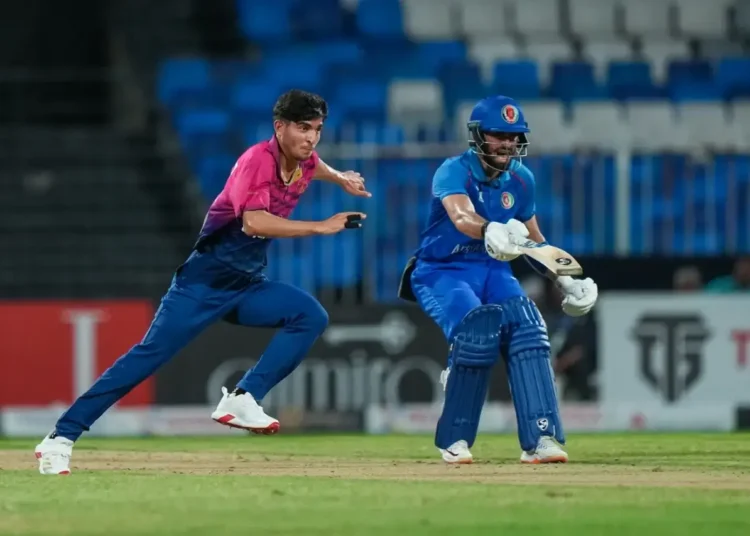The Sharjah tri-series match between Afghanistan and the UAE turned into a contest that few expected. A dead rubber came alive in the final over, where Fareed Ahmad was tasked with defending 16 runs. After being hit for a four and six off the first two balls, the game looked gone. Asif Khan was on 40 from just 25 deliveries and had the momentum. Yet, Afghanistan somehow held their nerve and pulled off a dramatic win.
This result carries more weight than just a thrilling finish. Afghanistan rotated six first-choice players, including Rashid Khan, yet still managed to edge through. Ibrahim Zadran led from the front with a fluent 48 and calm leadership. Rahmanullah Gurbaz, given a second life after a dropped catch, added 40. Karim Janat finished strong to push the score to 170 for four. On a slow pitch, that total looked more than competitive.
UAE showed plenty of firepower in their reply. Muhammad Waseem blazed early boundaries, while Asif Khan almost pulled off a famous win. But fielding lapses and middle-overs pressure proved costly again. Mujeeb Ur Rahman and Noor Ahmad bowled with skill to slow the chase, and Fareed sealed it at the death.
This game was more than a warm-up. It showed Afghanistan’s depth and UAE’s fighting spirit, while also raising questions ahead of the Asia Cup.
Afghanistan’s Depth and Calm Execution in Sharjah
Afghanistan showed why they remain a dark horse in any T20 contest. Even without Rashid Khan, Mohammad Nabi and several senior names, they still posted 170 and defended it. The batting foundation came through Rahmanullah Gurbaz and Ibrahim Zadran, who added 98 for the first wicket. Zadran’s 48 off 34 showed technical class, and Gurbaz accelerated after a shaky start to hit 40.
When wickets fell quickly in the middle overs, Karim Janat’s finishing kept momentum alive. He took advantage of loose bowling lengths, striking crucial boundaries that pushed Afghanistan beyond par. The balance between aggressive starts and composed finishing was evident.
With the ball, Afghanistan relied on spin and variation. Sharafuddin Ashraf bowled four tight overs for 20 runs, and Mujeeb once again proved almost unhittable. Noor Ahmad backed him up perfectly, choking the run rate at a vital stage. Fareed Ahmad’s final over heroics sealed the win, proving that the team could handle high-pressure situations.
This depth is encouraging. Bench players like Fareed, Janat and Noor stepped up, showing selectors that Afghanistan’s second string can handle responsibility. Heading into the Asia Cup, this adaptability may give them the edge in tight matches.
Tactical Signals for the Asia Cup
Afghanistan’s performance offers a few clear signals ahead of the tournament. Their batting thrives on partnerships rather than individual brilliance, and their spinners remain the backbone on slow decks. The ability to defend under pressure, even without senior leaders, underlines the squad’s composure. Selection committees will value this flexibility, especially with multiple back-to-back games coming up.
UAE’s Fighting Spirit and Areas for Growth
For the UAE, this game was a reminder of both their strengths and weaknesses. Muhammad Waseem once again set the tone in the powerplay, striking inventive boundaries and putting bowlers under pressure. He has become their most important batter, capable of providing explosive starts against any attack. Alongside him, Asif Khan has developed into a dangerous finisher. His 40 off 25 nearly stole the game, and his straight-hitting ability makes him a constant threat.
Bowling remains more inconsistent. Haider Ali impressed with two wickets and disciplined spin. Simranjeet Singh offered control as well, but lapses at the death and dropped catches hurt the team. Muhammad Rohid, in particular, was unlucky as fielding errors wasted his good work.
Despite losing, UAE’s aggressive batting and flashes of quality showed they can trouble higher-ranked teams. However, fielding discipline and tighter execution at the death will be crucial in the Asia Cup. Group A includes India and Pakistan, so small mistakes will quickly prove costly. To surprise in this group, UAE must cut out errors and sustain pressure for 40 overs.
Key Players to Watch
Muhammad Waseem will remain central to UAE’s hopes. His strike rate above 150 in 2025 highlights his consistency. Asif Khan is another who can change games late with clean hitting. Haider Ali’s left-arm spin offers control on slow UAE pitches, while Simranjeet provides a steady middle-overs option. The team’s chances will rest on these players producing together, rather than in patches.
Problems They Must Fix for the Future
Both Afghanistan and UAE need to address long-term issues. Afghanistan’s batting depth beyond the top three remains fragile, while UAE continue to struggle with fielding and consistency in death bowling. Domestic development must improve to supply more reliable options.
Equally important is the absence of proper women’s programs. Neither Afghanistan nor UAE has invested in women’s cricket teams at a competitive level. If they want to join the mainstream of global cricket, they must support women’s pathways. Nations like India and Bangladesh, who already have structured women’s programs, continue to grow the sport. Readers can learn more about the history of women’s cricket, including the first Women’s ODI World Cup, here: When was the first Women’s ODI World Cup played?.
Conclusion
The Sharjah thriller reminded fans how fine the margins are in T20 cricket. Afghanistan defended 16 in the last over, thanks to Fareed Ahmad’s calm head. Ibrahim Zadran’s leadership and Gurbaz’s innings provided balance, while the spinners ensured control. Even without Rashid Khan, Afghanistan proved they have the depth to remain competitive in Asia’s biggest tournament.
For UAE, the defeat was heartbreaking, but not without positives. Waseem’s aggression, Asif Khan’s finishing, and Haider Ali’s control show a core of quality. Yet, dropped catches, inconsistent bowling and lack of composure under pressure continue to cost them. To make the Super Four, they must improve discipline and grab key moments.
Beyond immediate results, both teams face bigger responsibilities. Afghanistan need to polish batting depth, and UAE must invest in better fielding and bowling development. Crucially, both must also step up in supporting women’s cricket. Without it, progress remains incomplete.
The Asia Cup will test these sides differently. Afghanistan look ready for a deep run, while UAE must punch above their weight to advance. If they learn from Sharjah and sharpen their execution, Group A could yet spring surprises.
















